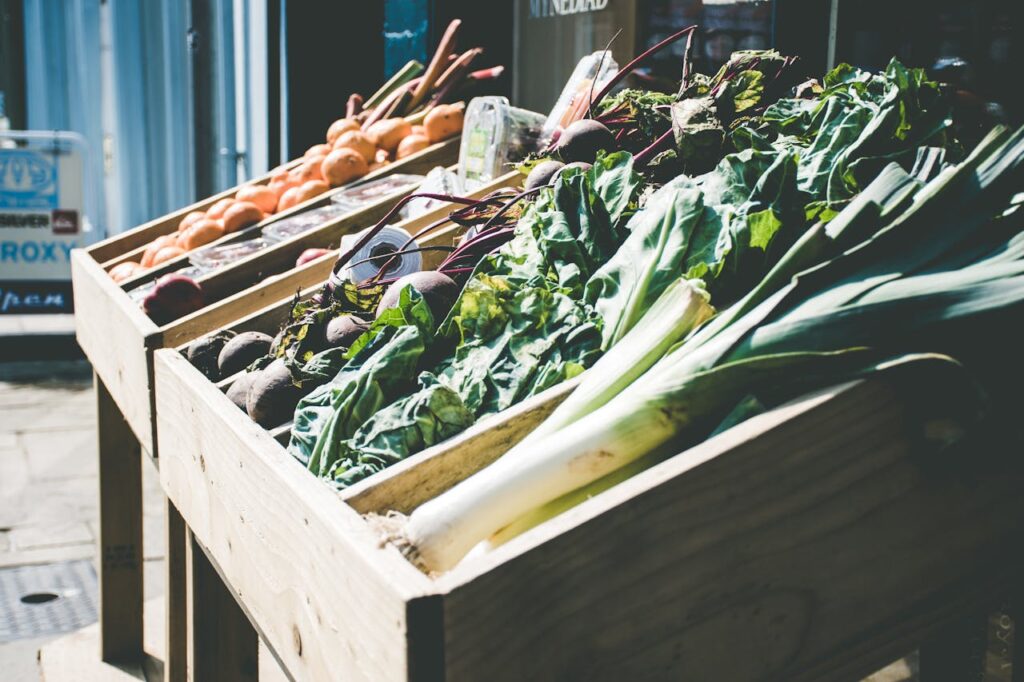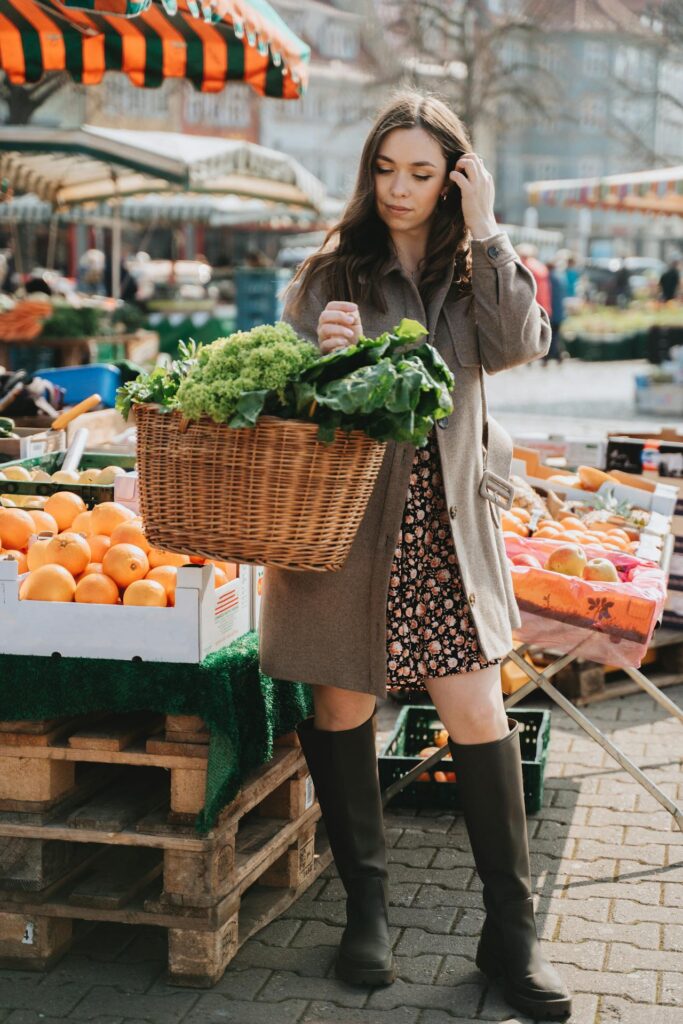The growing interest in seasonal and local food has sparked countless debates about health, environmental impact, and culinary quality. As farmers’ markets multiply and ‘locally sourced’ appears on more menus, it’s worth looking past the hype to understand what these food choices really mean for our diets, health and environment.
The Natural Rhythm Of Seasonal Food
The relationship between seasonality and nutrition is more profound than many people realise. When we eat produce in its natural growing season, we’re not just following tradition – we’re tapping into nature’s perfectly timed nutrition delivery system.
Research suggests that produce harvested in season can contain more vitamins and minerals than out-of-season alternatives. Why? Plants naturally accumulate nutrients based on their growing conditions, and seasonal growing allows them to develop according to their natural cycles.
Take spinach, for example. When grown in spring, it contains significantly higher levels of vitamin C and folate compared to winter-grown spinach cultivated in heated greenhouses. Similarly, winter vegetables like Brussels sprouts and parsnips develop higher concentrations of certain nutrients during cold weather exposure. This natural timing isn’t coincidental – it’s the result of millions of years of evolution, with plants adapting to provide optimal nutrition at specific times of the year.


The Cost Benefits Of Seasonal Eating
The economics of seasonal eating often surprise people who assume that better quality means higher prices. In reality, seasonal produce typically represents one of the best values in our food system, thanks to the basic principles of supply and demand combined with reduced production costs. When crops are grown and harvested in their natural season, they require fewer resources and interventions, which translates directly to lower prices at the market.
Seasonal produce typically costs less because:
- Lower energy inputs are required for growing
- Transport and storage costs are reduced
- Supply tends to be abundant during peak seasons
A recent article published by Yahoo Finance suggested that buying seasonal produce could reduce your grocery bill by up to 50% compared to buying out-of-season alternatives. This significant saving reflects not just the abundance of seasonal produce, but also the reduced costs associated with growing food in its natural cycle.

The Environmental Advantage
The environmental benefits of seasonal eating extend far beyond what most consumers realise. When we choose seasonal produce, we’re essentially aligning our diet with nature’s own energy-efficient system. Growing food in its natural season works with the environment rather than against it, requiring significantly fewer artificial inputs and interventions. This natural approach creates a cascade of environmental benefits that extend from the farm to our tables.
Growing food in its natural season requires fewer artificial inputs:
- Less artificial heating
- Reduced need for pesticides
- Lower water consumption
- Minimal artificial lighting
The Local Connection
The relationship between food miles and nutritional value presents one of the most complex and frequently misunderstood aspects of our food system. While the concept of ‘fresh is best’ seems straightforward, the reality involves a fascinating interplay between time, distance, and modern storage technologies. The question of whether local food is more nutritious isn’t just about distance – it’s about understanding how fruits and vegetables live, breathe, and change after harvest.
Some key findings:
- Certain nutrients, particularly vitamin C and folate, begin declining immediately after harvest
- A report by Reading University showed that some vegetables can lose up to half of their vitamin C within a a couple of days of harvest, though it should be noted that the report’s key takeaway was that frozen or tinned food was a wise move for this reason (more of that in a moment)
- However, modern storage techniques can help preserve nutrients in properly transported non-local food


The Case For Frozen & Preserved Foods
When discussing local and seasonal eating, there’s an unexpected hero in the nutrition story: frozen produce. As any registered dietitian will tell you, while there’s often a perception that frozen foods are somehow inferior to fresh, the science tells a different story. The rapid freezing process used today essentially presses pause on the degradation of nutrients, often resulting in frozen produce that’s more nutritious than its ‘fresh’ counterparts that have spent days in transit and storage.
The Reading University research pointed to a surprising truth: frozen produce can actually retain more nutritional value than fresh produce that’s been sitting in supply chains or your fridge for several days. This is particularly true for vitamin C, folate, and other water-soluble vitamins that begin degrading immediately after harvest. For example, frozen peas can contain more nutrients than fresh peas that are several days old, and frozen spinach often retains more folate than fresh spinach that’s been transported long distances.
This has important implications for both seasonal and local eating:
- During off-seasons, frozen local produce can be a more nutritious choice than fresh imports
- Freezing allows us to extend the benefits of peak-season produce throughout the year
- Local farmers and producers can freeze their produce at peak ripeness, maximizing both flavor and nutrition
- It provides a practical solution for accessing local produce year-round
The key is to think of frozen fruit and vegetables not as a compromise, but as a smart strategy for maintaining good nutrition while supporting local food systems. Many local farmers now offer frozen versions of their seasonal produce, creating a win-win situation: consumers get high-quality, nutrient-rich food year-round, while farmers can extend their market reach beyond the growing season.
Time & Freshness
The concept of freshness in our food system deserves closer examination, as it represents one of the clearest advantages of local food sourcing. While modern supply chains have become remarkably efficient at moving produce across vast distances, they still can’t compete with the fundamental advantage of proximity when it comes to time from harvest to plate.
Local food’s primary advantage isn’t necessarily superior nutrition, but rather freshness. Produce sold at farmers’ markets is typically harvested within 24 hours of sale, compared to supermarket produce which may be 7-14 days post-harvest. This difference in freshness affects not just nutritional content, but also taste, texture, and overall eating quality.
Understanding Environmental Impact
The environmental impact of local food presents a more nuanced picture than the popular ‘food miles’ narrative might suggest. While intuition tells us that shorter transportation distances must be better for the environment, the reality involves a complex web of factors including growing methods, seasonal timing, and storage requirements. Understanding these complexities helps us make more informed decisions about when local truly means more sustainable.
The ‘food miles’ debate isn’t as straightforward as it might seem:
- Transport accounts for ‘only’ 19% of food’s carbon footprint
- Growing methods often matter more than distance travelled
- Some local food grown in heated greenhouses may have a larger carbon footprint than imported alternatives
Making Better Choices
Understanding both the seasonal and local aspects of our food system empowers us to make choices that maximise benefits for our health, wallet, and environment. These two approaches naturally complement each other – eating seasonally often makes it easier to source locally, while focusing on local produce typically guides us toward seasonal eating patterns. The key is to understand how to combine these approaches effectively in your daily life.
Here’s how to embrace both seasonal and local eating:
- Start with what’s growing naturally in your region right now
- Build relationships with local farmers and producers who follow seasonal growing patterns
- Consider frozen alternatives from local producers for out-of-season produce
- Learn about your area’s growing calendar to anticipate what produce will be available when
Remember that both ‘seasonal’ and ‘local’ exist on a spectrum. Making even small shifts towards more seasonal and local consumption can provide benefits without requiring a complete overhaul of your shopping habits.
The Verdict
The evidence suggests that combining seasonal and local eating habits offers the most comprehensive benefits. When we eat food that’s both in season and locally sourced, we’re likely getting the best of both worlds: optimal nutrition from seasonal growing patterns, maximum freshness from local sourcing, cost benefits from seasonal abundance, and environmental advantages from both approaches.
The ideal approach? Think of seasonal and local as complementary guides that work together to help you make better food choices. This mindful approach to eating connects us more deeply with our food system, supports local economies, and helps ensure we’re getting the most nutritious, sustainable food possible. Start with what’s practical for your situation, and gradually build more seasonal and local choices into your regular shopping habits.





